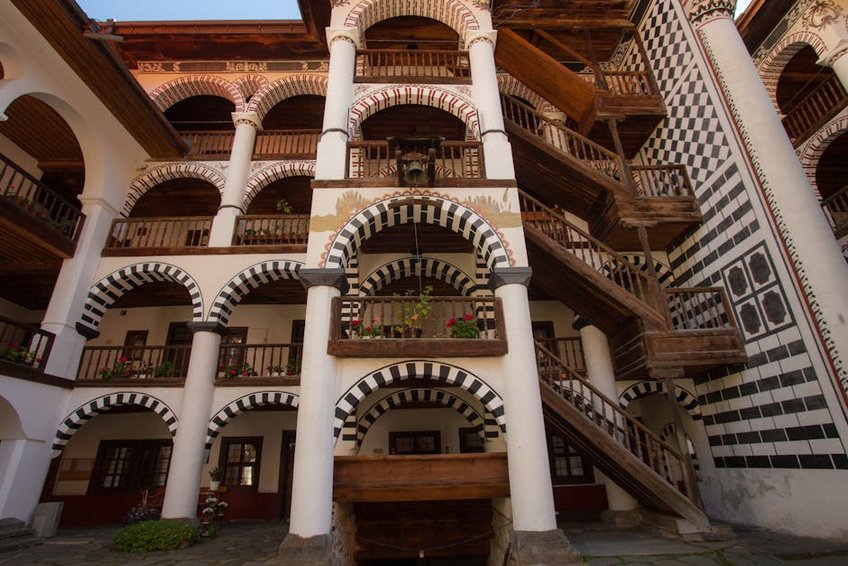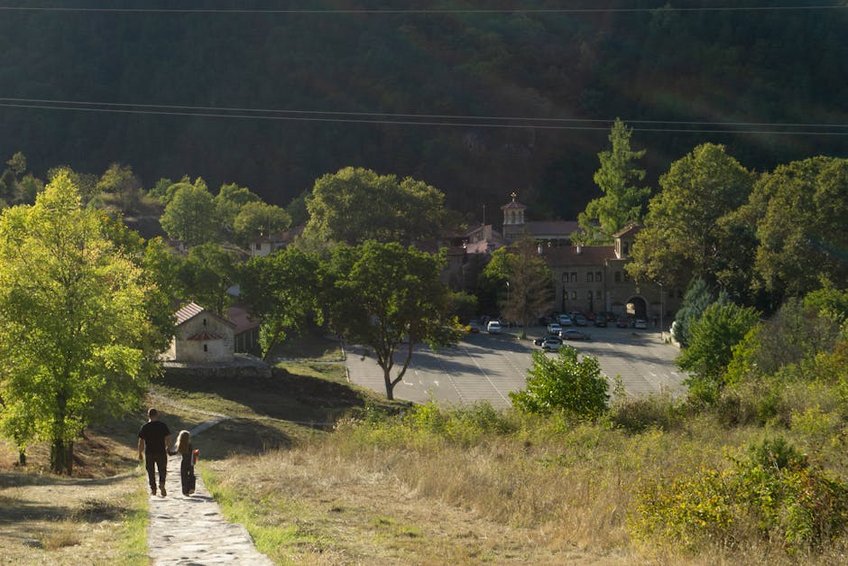Bulgaria Rila Monastery Snow: Your Ultimate Winter Guide
Experiencing Bulgaria Rila Monastery snow transforms this UNESCO site into a magical winter landscape where ancient Orthodox architecture meets pristine alpine scenery. Your visit reveals stunning frescoes against snow-draped courtyards and the serene Rila Mountains providing a breathtaking backdrop for photography and contemplation. This guide covers essential planning tips, cultural insights, and practical advice for navigating the monastery’s winter conditions successfully.
Essential Rila Monastery Information
Founded in the 10th century by Saint John of Rila, this spiritual center represents Bulgaria’s national revival with exquisite medieval art surviving centuries of history. The monastery complex spans 8,800 square meters featuring four-story residential wings surrounding the main Church of the Nativity. Its location within Rila National Park ensures protected natural surroundings at 1,147 meters elevation.
Winter access requires careful planning since mountain roads experience occasional closures during heavy snowfall between December and February. The monastery maintains regular visiting hours from 7:00 AM to 8:00 PM year-round, though religious services may affect tourist access during major Orthodox holidays. Always check current conditions before departing from Sofia.
Historical Significance and Architecture
The monastery’s architectural blend includes Byzantine, Bulgarian Renaissance, and Ottoman influences visible in its distinctive striped arches and domed church. Key historical moments include surviving destruction under Ottoman rule and housing revolutionary leaders during Bulgaria’s independence movement. The museum shelters priceless artifacts like the carved Rafail Cross containing 104 religious scenes and 1,500 miniature figures.
Location and Mountain Access
Rila Monastery sits 117 kilometers south of Sofia in the Rila Mountains, accessible via well-maintained but winding roads through picturesque villages like Kocherinovo. Public transportation options include daily buses from Sofia Central Station taking approximately 2.5 hours, though winter schedules may see reduced frequency. Driving yourself allows flexibility but requires winter tires from November through March.
- Road conditions vary dramatically with snow accumulation reaching 2-3 feet during January peaks, requiring 4WD vehicles for safe navigation.
- Guided tours from Sofia typically include transportation, monastery entry, and lunch stops at traditional mehana restaurants in nearby Blagoevgrad.
- Nearest amenities include limited accommodation in monastery guest houses and basic supplies at the small shop within the complex.
- Budget travelers spend $50-75 daily using public buses from Sofia ($15 roundtrip), self-catering meals, and monastery guest houses ($25-40 nightly). Save by bringing snacks and using student discounts for museum entry.
- Mid-range options cost $80-120 daily featuring guided tours from Sofia ($50-70 including transport), restaurant meals in Blagoevgrad ($15-25), and private guesthouses ($40-60) with heating.
- Luxury experiences range $130-150 daily with private drivers ($100-120), premium hotels in Borovets ($70-90), and professional photography tours ($60-80) including equipment.
- Official Rila Monastery Website
- Bulgaria Travel Official Tourism Portal
- Lonely Planet Rila Monastery Guide
Cultural Importance and Religious Context
As Bulgaria’s most important Orthodox monastery, it functions as both active religious community and cultural symbol attracting pilgrims and tourists alike. The complex houses approximately 60 monks following strict liturgical schedules with services conducted in Church Slavonic throughout the day. Visitors should dress modestly with covered shoulders and knees, particularly when entering the main church during services.

Alt: “rila-monastery-snow-covered-courtyard-winter-mountains”
Planning Your Bulgaria Rila Monastery Snow Trip
Organizing your Bulgaria Rila Monastery snow adventure demands attention to seasonal challenges and cultural considerations unique to winter mountain travel. December through February offers the most dramatic snow scenery but requires flexibility for weather-dependent road access and shorter daylight hours. Budget between $50-150 daily depending on transportation choices and accommodation style.
Essential preparations include waterproof boots with grip, layered clothing for temperatures ranging from 25°F to 35°F (-4°C to 2°C), and backup power banks for photography equipment. Book monastery guest house accommodations several weeks ahead since availability drops significantly during Orthodox Christmas celebrations in early January. Consider hiring local guides for historical context and safe mountain navigation.
Best Time to Visit Rila Monastery
Peak winter conditions occur from mid-December through February when snow blankets the monastery courtyards and surrounding forests create perfect photography conditions. Daytime temperatures typically range from 28°F to 35°F (-2°C to 2°C) with nighttime drops to 20°F (-7°C), requiring thermal layers and proper footwear. Visit weekdays between 10:00 AM and 2:00 PM for optimal lighting with fewer crowds.
Shoulder months of November and March offer occasional snow with milder temperatures between 35°F and 50°F (2°C to 10°C) and better road accessibility. These periods see fewer tourists but unpredictable weather patterns that might reduce snow coverage around the monastery complex. Early mornings provide the best photography light before day-trippers arrive from Sofia.
Budget Planning and Costs
Winter visits require allocating funds for potential transportation changes and cold-weather gear beyond standard travel expenses.
Essential Preparation Checklist
Packing for mountain winter conditions demands specific gear including insulated waterproof boots, thermal layers, traction devices for shoes, and portable chargers for electronics. Bring multiple camera batteries since cold drains power quickly, and consider a tripod for low-light interior photography of frescoes and icons. Research road conditions through the Bulgarian Ministry of Transport website before departure.
Required documentation includes valid passport, comprehensive travel insurance covering winter sports, and international driving permit if renting vehicles. Book accommodations at least three weeks ahead for December and January visits, confirming cancellation policies given potential weather disruptions. Learn basic Bulgarian phrases for greetings and directions to enhance interactions with local communities.
Top Winter Attractions and Activities
Beyond the main monastery complex, the surrounding Rila National Park offers snowshoeing trails, frozen waterfalls, and traditional village experiences complementing your cultural visit. The region’s natural beauty shines during winter with opportunities for landscape photography, wildlife spotting, and authentic Bulgarian cuisine in mountain taverns. Balance your itinerary between indoor cultural exploration and outdoor winter adventures.
Local guides provide invaluable context for understanding the monastery’s history while ensuring safe navigation of snow-covered paths and hidden architectural details. The museum’s collection includes rare manuscripts, liturgical objects, and historical exhibits that gain additional atmosphere when viewed during shorter winter days. Evening visits sometimes coincide with candlelit services creating magical photographic moments.
Must-See Monastery Highlights
The main Church of the Nativity features breathtaking frescoes by Zahari Zograf depicting biblical scenes and Bulgarian saints, with snow-framed arches creating perfect winter compositions. The monastery museum houses the legendary Rafail Cross, a wooden masterpiece requiring 12 years of meticulous carving, alongside medieval gospels and royal donations. The defensive tower from the 14th century offers panoramic views over snow-covered courtyards.
Hrelyo’s Tower stands as the oldest building within the complex, containing the Transfiguration Chapel with well-preserved 14th-century frescoes visible during guided tours. The monastery kitchen with its massive chimney and original copper cauldrons illustrates medieval monastic life, particularly atmospheric during winter when historical context feels most tangible. The central courtyard’s ancient well becomes an ice sculpture in freezing conditions.
Hidden Gems and Local Favorites
Stroll to the nearby St. Luke’s Hermitage, a smaller chapel accessible via snow-covered path offering solitude and alternative monastery perspectives rarely seen by day-trippers. The village of Pastra features traditional Bulgarian houses with snow-laden roofs and family-run taverns serving authentic banitsa and kebapche during winter months. Local guides know secluded viewpoints for photographing the monastery against sunrise through mountain mists.
The Rila Mountains’ lower trails remain accessible with proper footwear, leading to frozen streams and wildlife tracking opportunities for red deer and Balkan chamois. Visit the monastery’s bakery early morning for warm mekitsi (fried dough) prepared by monks, available only during specific hours. The gift shop sells handmade icons and rose oil products from Bulgaria’s Valley of Roses at reasonable prices.
Winter Photography Techniques
Capture the monastery’s snow-covered architecture using polarizing filters to reduce glare and emphasize intricate woodcarvings against white backgrounds. Arrive during golden hour before sunset when low-angle light illuminates frescoes and creates long shadows across snowy courtyards, enhancing texture and depth. Use tripods for interior shots without flash to preserve the ambiance of candlelit spaces and detailed iconography.
Experiment with black and white photography to highlight the dramatic contrast between dark wooden beams and fresh snow accumulation on roofs and arches. Include human elements for scale, such as monks crossing courtyards or visitors admiring frescoes, to convey the site’s living spiritual tradition. Protect equipment from temperature changes by acclimatizing cameras gradually between indoor and outdoor environments.
Practical Winter Travel Information
Transportation during snow season requires contingency planning with possible road closures affecting both self-drive and public bus options between Sofia and the monastery. Accommodation choices range from basic monastery cells to comfortable guesthouses in nearby towns, all requiring advance booking during popular winter holiday periods. Prepare for limited services with shorter operating hours at restaurants and shops in the immediate vicinity.
Essential apps include Google Maps for navigation, BGMeteo for accurate mountain weather forecasts, and Avtovazdi for checking real-time road conditions across Bulgaria. Currency exchange should be completed in Sofia since ATMs near the monastery are scarce and may experience outages during severe weather. Keep emergency contacts including local taxi services and the monastery’s guest information number.
| Category | Options/Features | Price Range (USD) |
|---|---|---|
| Accommodation | Monastery guest houses with shared bathrooms, heating; private guesthouses in Rila village with en suite | $25-60 nightly |
| Transportation | Public buses from Sofia, private taxis, rental cars with snow tires, organized tours including guide | $15-120 roundtrip |
| Food & Dining | Monastery refectory meals, village taverns with traditional Bulgarian cuisine, self-catering options | $8-25 daily |
| Activities & Tours | Guided monastery tours, photography workshops, snowshoeing in national park, cultural presentations | $20-80 per experience |


